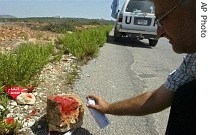2006年VOA标准英语-UN Agencies to Clear Unexploded Munitions in Le(在线收听)
By Lisa Schlein
Geneva
31 August 2006
U.N. agencies are joining forces to clear unexploded munitions they say is endangering the lives of tens of thousands returning to Lebanon. The U.N. refugee agency (UNHCR) has signed a formal partnership with the U.N. Mine Action Service for the rapid clearing of unexploded weapons scattered across southern Lebanon.
-----
 UNHCR says thousands of cluster bombs and other explosives scattered across southern Lebanon |
||
The Lebanese government reports most of the approximately one million people who fled during the conflict have returned home. But UNHCR spokesman Ron Redmond tells VOA in many cases, access to both their houses and the fields that provide their livelihoods has been blocked by unexploded ordnance.
"Even those people who are back in their houses or at least on their property are reporting finding cluster bombs and other explosives on a daily basis," he said. "We have been asked by municipality leaders to provide mine awareness training for the children in several areas, especially around Tyre because those children are outside, they are playing, they see these unexploded ordnance, cluster bombs and so on and they do not know what they are."
The Lebanese Army reports since the August 14 ceasefire, 11 people have been killed and 50 wounded by unexploded weapons, most of them were victims of cluster bombs. The U.N. Humanitarian chief, Jan Egeland, says tens of thousands of cluster bombs are scattered throughout Lebanon. Redmond says these weapons pose a particular danger to children.
"The bomblets from these cluster bombs can appear to be balls or small toys," he added. "They are quite small and, in some cases, they are spherical so children can mistake them for a ball or some other kind of toy. So, unless children are educated to stay away from these things and are shown pictures of what they can look like, they can really be in jeopardy."
The U.N. refugee agency and the U.N. Mine Action Service have cooperated on other mine clearance projects in recent months, including in south Sudan. But Redmond notes this is the first time the two agencies have cooperated on a rapid response to major contamination by unexploded ordnance during a humanitarian emergency.